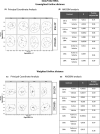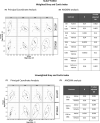Continuous clinical improvement of mild-to-moderate seborrheic dermatitis and rebalancing of the scalp microbiome using a selenium disulfide-based shampoo after an initial treatment with ketoconazole
- PMID: 34416081
- PMCID: PMC10234447
- DOI: 10.1111/jocd.14362
Continuous clinical improvement of mild-to-moderate seborrheic dermatitis and rebalancing of the scalp microbiome using a selenium disulfide-based shampoo after an initial treatment with ketoconazole
Abstract
Objective: Scalp seborrheic dermatitis (SD) is a chronic, relapsing, and inflammatory scalp disease. Studies indicate a global bacterial and fungal microbiota shift of scalp SD, as compared to healthy scalp. Ketoconazole and selenium disulfide (SeS2 ) improve clinical signs and symptoms in both scalp dandruff and SD.
Aim: The main objective of this study was to investigate the changes in the scalp microbiota diversity and counts in subjects with scalp SD during a two-phase treatment period.
Material and methods: The scalp microbiota and clinical efficacy were investigated in 68 subjects with mild-to-moderate scalp SD after an initial one-month treatment with 2% ketoconazole, and after a 2-month maintenance phase, either with a 1% SeS2 -based shampoo or its vehicle.
Results: Thirty one subjects in the active and 37 subjects in the vehicle group participated. Ketoconazole provided an improvement of clinical symptoms (adherent (-1.75 p < 0.05), non-adherent (-1.5, p < 0.05)) flakes and erythema (scores 1.67-0.93, p < 0.001), in an increased fungal diversity and in a significant (p < 0.005) decrease of Malassezia spp. SeS2 provided an additional clinical improvement (-0.8; p = 0.0002 and -0.7; p = 0.0081 for adherent and non-adherent flakes, respectively, at Day 84) compared to the vehicle associated with a low Malassezia spp. count and an additional significant (p < 0.001) decrease of the Staphylococcus spp. level.
Conclusion: Selenium disulfide provides an additional benefit on the scalp microbiota and in clinical symptoms of SD and dandruff after treatment with ketoconazole. The results confirm the role of Staphylococcus spp. in scalp SD and open possible perspectives for preventing relapses.
Keywords: ketoconazole; scalp microbiota; seborrheic dermatitis; selenium disulfide.
© 2021 L’OREAL. Journal of Cosmetic Dermatology published by Wiley Periodicals LLC.
Conflict of interest statement
PM, CC, MT, AO, CM and AG are employees of L'Oréal Research and Innovation. DK is an employee of Vichy Laboratoires, AB was an employee of Vichy Laboratoires at the time the study was conducted. PR received honoraria from L’Oréal to conduct the study.
Figures






References
-
- Wikramanayake TC, Borda LJ, Miteva M, Paus R. Seborrheic dermatitis‐looking beyond Malassezia. Exp Dermatol. 2019;28(9):991‐1001. - PubMed
-
- Hay RJ. Malassezia, dandruff and seborrhoeic dermatitis: an overview. Br J Dermatol. 2011;165(Suppl 2):2‐8. - PubMed
-
- Grice EA, Dawson TL Jr. Host‐microbe interactions: Malassezia and human skin. Curr Opin Microbiol. 2017;40:81‐87. - PubMed
-
- Theelen B, Cafarchia C, Gaitanis G, Bassukas ID, Boekhout T, Dawson TL Jr. Malassezia ecology, pathophysiology, and treatment. Med Mycol. 2018;56(suppl_1):S10‐S25. - PubMed
MeSH terms
Substances
Grants and funding
LinkOut - more resources
Full Text Sources
Other Literature Sources
Medical
Miscellaneous

